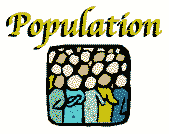|
Population:
|
|
13,711,597 (July 2009 est.)
country comparison to the world: 68
|
|
|
Age structure:
|
|
0-14 years: 42.2% (male 2,911,324/female 2,877,804)
15-64 years: 54.8% (male 3,728,664/female 3,786,000)
65 years and over: 3% (male 190,343/female 217,462) (2009 est.)
|
|
|
Median age:
|
|
total: 18.6 years
male: 18.4 years
female: 18.8 years (2009 est.)
|
|
|
Population growth rate:
|
|
2.709% (2009 est.)
country comparison to the world: 22
|
|
|
Birth rate:
|
|
36.84 births/1,000 population (2009 est.)
country comparison to the world: 29
|
|
|
Death rate:
|
|
9.75 deaths/1,000 population (July 2009 est.)
country comparison to the world: 68
|
|
|
Net migration rate:
|
|
0 migrant(s)/1,000 population (2009 est.)
country comparison to the world: 84
|
|
|
Urbanization:
|
|
urban population: 42% of total population (2008)
rate of urbanization: 3.1% annual rate of change (2005-10 est.)
|
|
|
Sex ratio:
|
|
at birth: 1.03 male(s)/female
under 15 years: 1.01 male(s)/female
15-64 years: 0.98 male(s)/female
65 years and over: 0.88 male(s)/female
total population: 0.99 male(s)/female (2009 est.)
|
|
|
Infant mortality rate:
|
|
total: 58.94 deaths/1,000 live births
country comparison to the world: 40
male: 65.7 deaths/1,000 live births
female: 51.98 deaths/1,000 live births (2009 est.)
|
|
|
Life expectancy at birth:
|
|
total population: 59 years
country comparison to the world: 186
male: 57.12 years
female: 60.93 years (2009 est.)
|
|
|
Total fertility rate:
|
|
4.95 children born/woman (2009 est.)
country comparison to the world: 31
|
|
|
HIV/AIDS - adult prevalence rate:
|
|
1% (2007 est.)
country comparison to the world: 54
|
|
|
HIV/AIDS - people living with HIV/AIDS:
|
|
67,000 (2007 est.)
country comparison to the world: 57
|
|
|
HIV/AIDS - deaths:
|
|
1,800 (2007 est.)
country comparison to the world: 63
|
|
|
Major infectious diseases:
|
|
degree of risk: very high
food or waterborne diseases: bacterial and protozoal diarrhea, hepatitis A, and typhoid fever
vectorborne diseases: Crimean-Congo hemorrhagic fever, dengue fever, malaria, Rift Valley fever, and yellow fever
water contact disease: schistosomiasis
respiratory disease: meningococcal meningitis
animal contact disease: rabies (2009)
|
|
|
Nationality:
|
|
noun: Senegalese (singular and plural)
adjective: Senegalese
|
|
|
Ethnic groups:
|
|
Wolof 43.3%, Pular 23.8%, Serer 14.7%, Jola 3.7%, Mandinka 3%, Soninke 1.1%, European and Lebanese 1%, other 9.4%
|
|
|
Religions:
|
|
Muslim 94%, Christian 5% (mostly Roman Catholic), indigenous beliefs 1%
|
|
|
Languages:
|
|
French (official), Wolof, Pulaar, Jola, Mandinka
|
|
|
Literacy:
|
|
definition: age 15 and over can read and write
total population: 39.3%
male: 51.1%
female: 29.2% (2002 est.)
|
|
|
Education expenditures:
|




